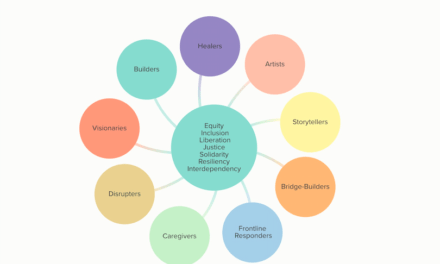“We will not go back to normal. Normal never was. Our pre-corona existence was not normal other than we normalized greed, inequity, exhaustion, depletion, extraction, disconnection, confusion, rage, hoarding, hate and lack. We should not long to return my friends. We are being given the opportunity to stitch a new garment.”
Sonya Renee Taylor
The last 18 months of global disruption due to the pandemic have dealt a complete paradigm shift to what we consider “normal” at work. Organizations are now seeing the fallout of the many months (and years) of burnout in the form of the Great Resignation. According to McKinsey, over 15 million U.S. workers have quit their jobs since April 2021, and 40% of workers said they would consider quitting in the next three to six months. It’s common for humans to reexamine large life and job related decisions when faced with existential threats, according to Clay Routledge from the Harvard Business Review. “They become more focused on what makes their lives feel fulfilling because meaning reduces existential anxiety by helping them feel like they’re part of something larger and longer-lasting than their brief, mortal lives,” he writes.
With the Great Resignation underway and showing no signs of slowing down, leaders are facing greater incentive to reshape their organizations to be more inclusive. Early findings from a July 2021 Wiley report already point to a lack of inclusion as a driver for turnover. Over half of 18- to 28-year-olds surveyed stated they left or contemplated leaving their tech job “because the company culture made them feel unwelcome or uncomfortable,” with even higher numbers for Black respondents (56%) and Hispanic or Latino respondents (58%). While the lived experience of exclusion for underrepresented employees is nothing new, this moment is calling on organizations to do some introspection. If leaders want to take an inclusive approach to understanding their retention challenges, it’s critical to hone in on the experiences of underrepresented employees. Consider these steps:
With the Great Resignation underway and not slowing down, leaders are facing greater incentive to reshape their organizations to be more inclusive. Early findings already point to a lack of inclusion as a driver for turnover. Click To Tweet
1.) Measure engagement AND enablement
As organizations seek to understand the wave of attrition we’re observing, many will look to measure employee engagement to get a temperature check on how current employees feel about their experience at the organization. When administering these surveys, it’s important to not only measure engagement, but enablement. Often, employee engagement surveys fail to take into account the nuanced experience underrepresented employees have at work that affect their engagement – lack of access to resources, professional development, and mentoring networks. “It is unreasonable to expect employees to be fully engaged at work when they felt their basic needs (i.e., meaningfulness, safety, and availability) were not being met as a result of their work experience” (Shuck, Collins & Rocco 2016). Incorporating questions that measure whether employees have equal access to the resources necessary for success and upward mobility is crucial to understanding retention of different demographic groups of employees.
Employee engagement surveys fail to take into account the nuanced experience underrepresented employees have at work that affect engagement - lack of access to resources, development, and mentoring networks. Click To Tweet
2.) Don’t treat turnover data as a monolith
Too often, organizations approach employee engagement with a ‘one size fits all’ approach, though we know that identity and intersectionality deeply impact all facets of the employee lifecycle. As leaders seek to gain insights from attrition and retention data, it’s important to aggregate findings to understand exactly who is leaving – and why. Consider these questions:
- When examining exit interviews, are there observable trends amongst underrepresented employees?
- How do results from employee engagement surveys differ among underrepresented groups? How do they differ when considering intersectionality?
Exit interviews and employee surveys can be invaluable ways to glean insights from employees – but it’s important to make sure your data analysis doesn’t create an erasure of the experiences from underrepresented groups.
Exit interviews and employee surveys can be invaluable ways to glean insights from employees - but it’s important to make sure your data analysis doesn’t create an erasure of the experiences from underrepresented groups. Click To Tweet
3.) Understand the toll on underrepresented employees
When an employee departs an organization, it can have a substantial impact on fellow colleagues and teammates. The implications for underrepresented employees are even greater. In demographically homogeneous organizations, underrepresented employees build strong networks with peers. When someone exits the organization, it makes an already small population smaller. It can also be additive to the lived experience of othering for underrepresented employees. In addition to facing institutional barriers to success in the workplace, marginalized folks must navigate the burden of stereotype threat, or perceived risk of confirming negative stereotypes about their social group. It’s critical to understand that employee departures do not impact all employees equally – for some it might mean being the “only” in the room again.
When an employee departs an organization, it can have a substantial impact on fellow colleagues and teammates. The implications for underrepresented employees are even greater. Click To Tweet
4.) Know the do’s and don’ts of eliciting feedback
Organizations that involve underrepresented employees in crafting retention efforts will continue to foster trust and engagement. As leaders reflect on findings from the Great Resignation, it’s important to include underrepresented employees in the process of reimagining the organization, with intention.
- Do meet folks exactly where they are. Jessica Bantom writes that in addition to including underrepresented folks in decision making, be intentional in asking how they want to be involved. “Do not make assumptions about how people will want to engage, in what capacity, and to what extent” she writes.
- Don’t place the burden on underrepresented folks to shoulder your DEIB retention and hiring efforts. Looking to bring new underrepresented talent to the organization? While employee referral programs are great networks to tap into, they can’t be the only strategy when it comes to hiring underrepresented talent. Understand that employee resource groups and networks are spaces for employees to feel included, safe and not have to engage in emotional labor.
There are many insights to be gained as leaders confront the Great Resignation, and with that great opportunity in reimagining what an inclusive organization could be. In order to retain underrepresented talent, organizations must observe diligently how past patterns no longer serve the workforce of today – and that being intentional when it comes to inclusion is the only way through.




















